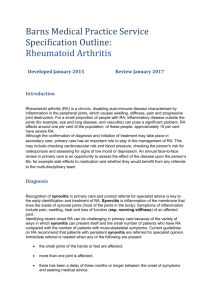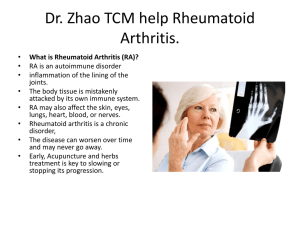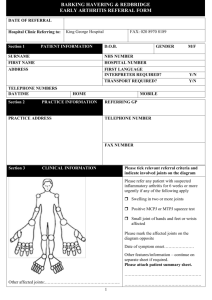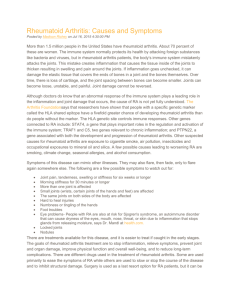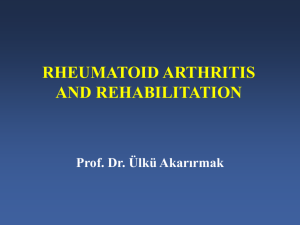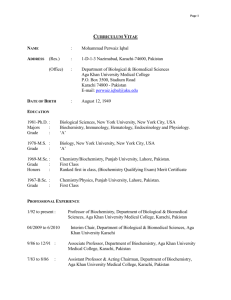Rheumatoid Arthritis
advertisement
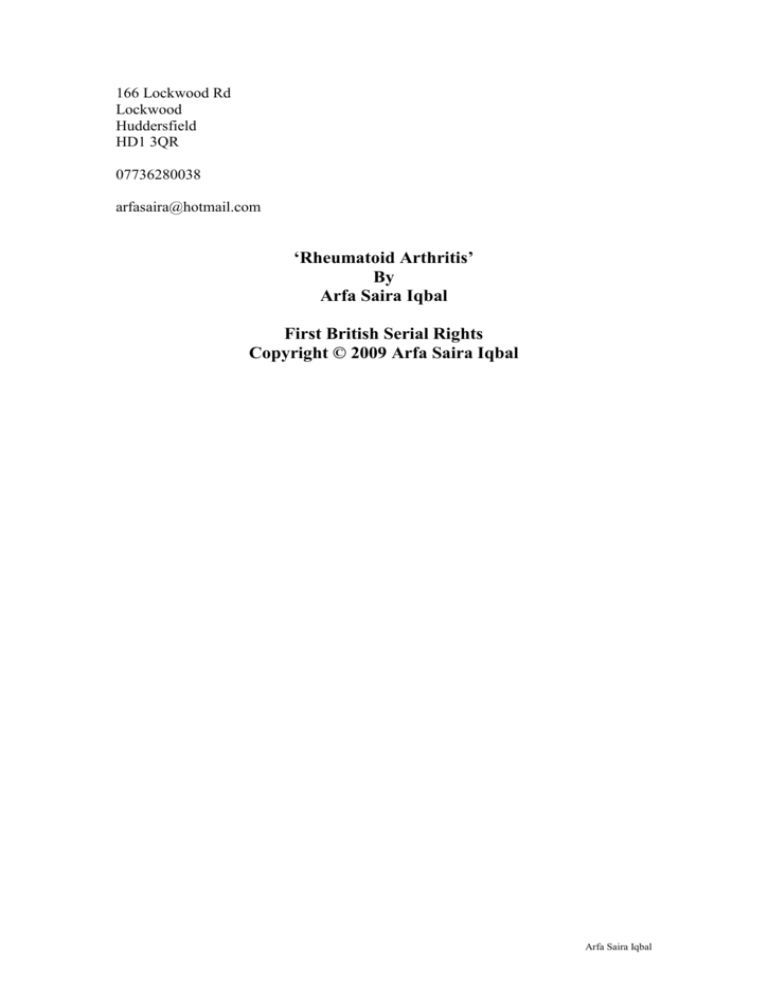
166 Lockwood Rd Lockwood Huddersfield HD1 3QR 07736280038 arfasaira@hotmail.com ‘Rheumatoid Arthritis’ By Arfa Saira Iqbal First British Serial Rights Copyright © 2009 Arfa Saira Iqbal Arfa Saira Iqbal Rheumatoid Arthritis Mention rheumatoid arthritis to anyone, and the chances are that they think it’s a disease that affects old people. This certainly is not the case. Although the disease usually affects people over the age of forty, an increasing number of young people are also being afflicted with this debilitating condition. Unlike osteoarthritis which affects just the joints, rheumatoid arthritis (RA) is an autoimmune disease that affects both joints and tissues. In principle, the body attacks itself and causes excruciating pain. Organs are also affected and can include the lungs, heart and eyes. Your joints and cartilage may become extremely stiff (ankylosis) and inflamed and mobility is greatly reduced. Simple everyday tasks such as brushing your teeth, combing your hair and even eating can become difficult, and in some cases, patients can become wheelchair bound depending on the severity of the disease. RA is more common in women than men and can be detected by inflammatory markers in the blood, the most common of which are ESR and CRP, as well as the following signs and symptoms: Hot, stiff, swollen and painful joints which tend to be worse in the morning Deformity in the joints, most commonly the hands, feet and knees (detected by x-ray) Tender joints which hurt to touch Swelling or lumps under the skin (known as rheumatoid nodules) Unexplained rashes, ulcers and discolouring of the skin Problems with organs such as the kidneys, heart and lungs (impaired function) as well as the eyes General tiredness, fever and weight loss You need to have some of these symptoms for at least six weeks before you can be diagnosed with RA. Your GP will send you for blood tests and perhaps X-rays to confirm diagnosis. The exact cause of RA is not yet fully understood or known, but it’s thought to run in families and can be caused by shock and trauma or extreme stress. There is also evidence to suggest that severe injury to a joint can trigger RA, although why this happens remains a mystery. There is at present, no known cure for RA. If you suspect that you have RA, don’t delay in seeking a diagnosis. The earlier the disease is caught the greater the chance of maintaining it and preventing further deterioration. Treatment is dependent on the severity of RA, but will almost always be a two-fold approach: preventing the disease from progressing and managing the pain. Your GP will prescribe drugs known as DMARDs (disease modifying anti-rheumatic drugs) which should help to slow down damage to your joints. In theory, these drugs will prevent RA from getting worse, although this does not mean to say that you will not deteriorate. Methotrexate (a form of chemotherapy) is one of the most powerful DMARDs, and is usually prescribed to patients who don’t respond to other drugs or whose condition worsens considerably. Other drugs include the use of oral steroids to help with reducing inflammation and if this doesn’t seem to help, individual joints can be injected with Kenalog (steroid) to Arfa Saira Iqbal help with pain management. Kenalog should last around three months, and cannot be used repeatedly. Some patients find that injected joints feel great, but in some cases, the effects only last a few weeks. Consultants are reluctant to use steroids over a long period of time as this in itself can thin the bones creating more problems in the future. As for managing the pain, analgesics and painkillers are the normal port of call. Anything from paracetamol to high strength codeine and ibuprofen (which actually helps reduce inflammation) can be used for general pain. Other treatments that can help in the management of RA include: Acupuncture Api therapy (bee sting therapy) Physiotherapy Special diets (reduced carb diets seem to lessen pain) Radon therapy (using radio-active gas) Fasting Hydrotherapy It is important to remember that the above are in addition to treatment you would receive and that not all consultants are willing to use these methods. If all else fails and RA is chronic, there is a new treatment known as anti-TNF therapy which involves injecting patients with a special drug that destroys the cells that are the root cause of inflammation in the body. The treatment is extremely expensive and is only considered by consultants for those patients for whom everything else has failed. It is not a cure and although it works brilliantly for some patients, it has little effect in others. RA is a complex disease and although sufferers tend to have a number of the symptoms mentioned above, progression of the disease can vary drastically from one person to the next. However, if it isn’t diagnosed early and managed accordingly it can lead to irreversible joint deformity and can devastate your life. It’s important for sufferers to understand that treatment will be a lifelong need and that the best way to deal with RA is to try and make changes to your lifestyle and find ways of doing things that work for you – you may have to find different ways of doing things you love. But in any case, a positive frame of mind is crucial if you want to lead a ‘normal’ life. Arfa Saira Iqbal



